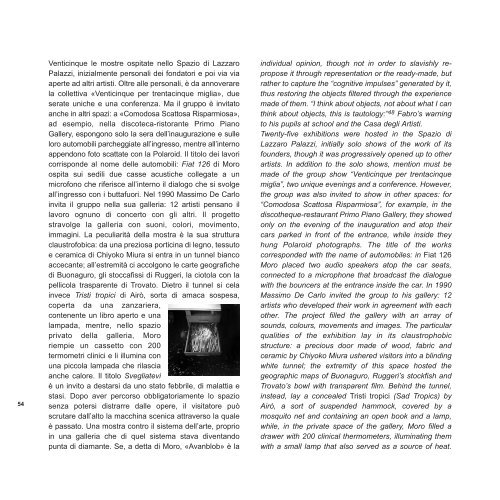Adachiara Zevi - arteinmemoria
Adachiara Zevi - arteinmemoria
Adachiara Zevi - arteinmemoria
Create successful ePaper yourself
Turn your PDF publications into a flip-book with our unique Google optimized e-Paper software.
54<br />
Venticinque le mostre ospitate nello Spazio di Lazzaro<br />
Palazzi, inizialmente personali dei fondatori e poi via via<br />
aperte ad altri artisti. Oltre alle personali, è da annoverare<br />
la collettiva «Venticinque per trentacinque miglia», due<br />
serate uniche e una conferenza. Ma il gruppo è invitato<br />
anche in altri spazi: a «Comodosa Scattosa Risparmiosa»,<br />
ad esempio, nella discoteca-ristorante Primo Piano<br />
Gallery, espongono solo la sera dell’inaugurazione e sulle<br />
loro automobili parcheggiate all’ingresso, mentre all’interno<br />
appendono foto scattate con la Polaroid. Il titolo dei lavori<br />
corrisponde al nome delle automobili: Fiat 126 di Moro<br />
ospita sui sedili due casse acustiche collegate a un<br />
microfono che riferisce all’interno il dialogo che si svolge<br />
all’ingresso con i buttafuori. Nel 1990 Massimo De Carlo<br />
invita il gruppo nella sua galleria: 12 artisti pensano il<br />
lavoro ognuno di concerto con gli altri. Il progetto<br />
stravolge la galleria con suoni, colori, movimento,<br />
immagini. La peculiarità della mostra è la sua struttura<br />
claustrofobica: da una preziosa porticina di legno, tessuto<br />
e ceramica di Chiyoko Miura si entra in un tunnel bianco<br />
accecante; all’estremità ci accolgono le carte geografiche<br />
di Buonaguro, gli stoccafissi di Ruggeri, la ciotola con la<br />
pellicola trasparente di Trovato. Dietro il tunnel si cela<br />
invece Tristi tropici di Airò, sorta di amaca sospesa,<br />
coperta da una zanzariera,<br />
contenente un libro aperto e una<br />
lampada, mentre, nello spazio<br />
privato della galleria, Moro<br />
riempie un cassetto con 200<br />
termometri clinici e li illumina con<br />
una piccola lampada che rilascia<br />
anche calore. Il titolo Svegliatevi<br />
è un invito a destarsi da uno stato febbrile, di malattia e<br />
stasi. Dopo aver percorso obbligatoriamente lo spazio<br />
senza potersi distrarre dalle opere, il visitatore può<br />
scrutare dall’alto la macchina scenica attraverso la quale<br />
è passato. Una mostra contro il sistema dell’arte, proprio<br />
in una galleria che di quel sistema stava diventando<br />
punta di diamante. Se, a detta di Moro, «Avanblob» è la<br />
individual opinion, though not in order to slavishly repropose<br />
it through representation or the ready-made, but<br />
rather to capture the “cognitive impulses” generated by it,<br />
thus restoring the objects filtered through the experience<br />
made of them. “I think about objects, not about what I can<br />
think about objects, this is tautology:” 48 Fabro’s warning<br />
to his pupils at school and the Casa degli Artisti.<br />
Twenty-five exhibitions were hosted in the Spazio di<br />
Lazzaro Palazzi, initially solo shows of the work of its<br />
founders, though it was progressively opened up to other<br />
artists. In addition to the solo shows, mention must be<br />
made of the group show “Venticinque per trentacinque<br />
miglia”, two unique evenings and a conference. However,<br />
the group was also invited to show in other spaces: for<br />
“Comodosa Scattosa Risparmiosa”, for example, in the<br />
discotheque-restaurant Primo Piano Gallery, they showed<br />
only on the evening of the inauguration and atop their<br />
cars parked in front of the entrance, while inside they<br />
hung Polaroid photographs. The title of the works<br />
corresponded with the name of automobiles: in Fiat 126<br />
Moro placed two audio speakers atop the car seats,<br />
connected to a microphone that broadcast the dialogue<br />
with the bouncers at the entrance inside the car. In 1990<br />
Massimo De Carlo invited the group to his gallery: 12<br />
artists who developed their work in agreement with each<br />
other. The project filled the gallery with an array of<br />
sounds, colours, movements and images. The particular<br />
qualities of the exhibition lay in its claustrophobic<br />
structure: a precious door made of wood, fabric and<br />
ceramic by Chiyoko Miura ushered visitors into a blinding<br />
white tunnel; the extremity of this space hosted the<br />
geographic maps of Buonaguro, Ruggeri’s stockfish and<br />
Trovato’s bowl with transparent film. Behind the tunnel,<br />
instead, lay a concealed Tristi tropici (Sad Tropics) by<br />
Airò, a sort of suspended hammock, covered by a<br />
mosquito net and containing an open book and a lamp,<br />
while, in the private space of the gallery, Moro filled a<br />
drawer with 200 clinical thermometers, illuminating them<br />
with a small lamp that also served as a source of heat.


